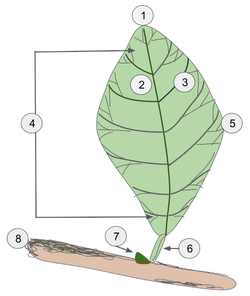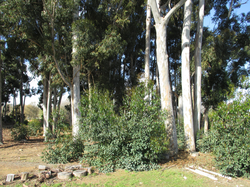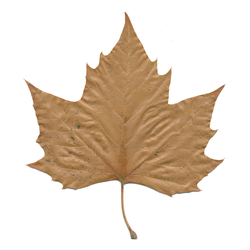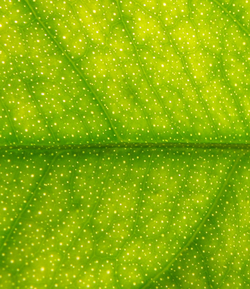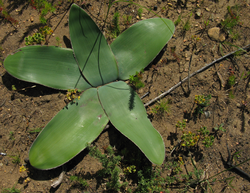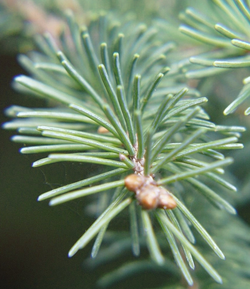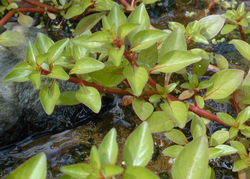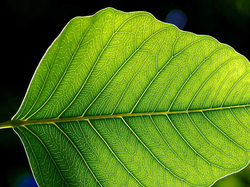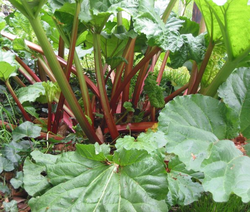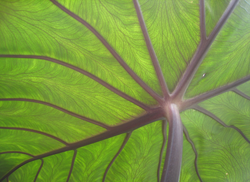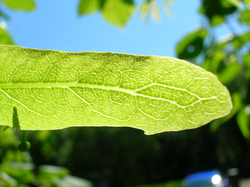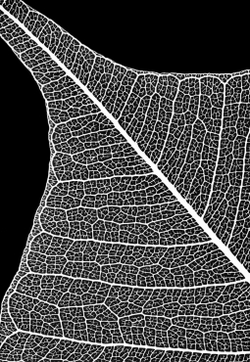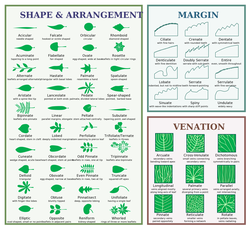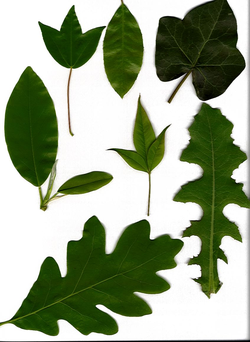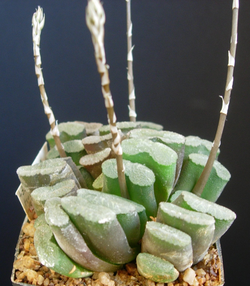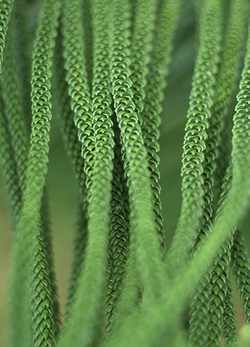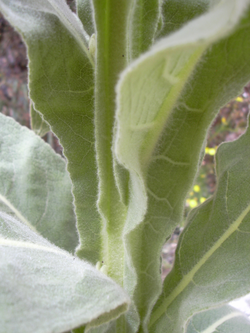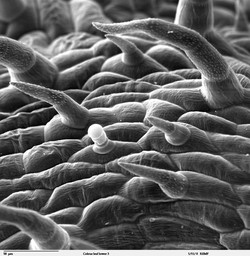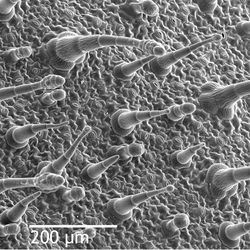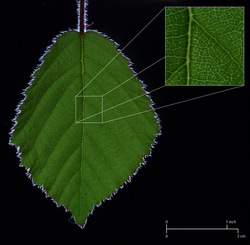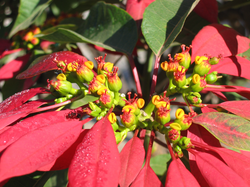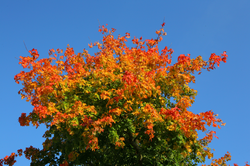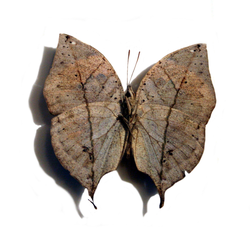Leaf
Leaf
A leaf is an organ of a vascular plant and is the principal lateral appendage of the stem. The leaves and stem together form the shoot. Leaves are collectively referred to as foliage, as in "autumn foliage".
Although leaves can be seen in many different shapes, sizes and textures, typically a leaf is a thin, dorsiventrally flattened organ, borne above ground and specialized for photosynthesis. In most leaves, the primary photosynthetic tissue, the palisade mesophyll, is located on the upper side of the blade or lamina of the leaf but in some species, including the mature foliage of Eucalyptus , palisade mesophyll is present on both sides and the leaves are said to be isobilateral. Most leaves have distinctive upper surface (adaxial) and lower surface (abaxial) that differ in colour, hairiness, the number of stomata (pores that intake and output gases), epicuticular wax amount and structure and other features.
Broad, flat leaves with complex venation are known as megaphylls and the species that bear them, the majority, as broad-leaved or megaphyllous plants. In others, such as the clubmosses, with different evolutionary origins, the leaves are simple, with only a single vein and are known as microphylls.
Some leaves, such as bulb scales are not above ground, and in many aquatic species the leaves are submerged in water. Succulent plants often have thick juicy leaves, but some leaves are without major photosynthetic function and may be dead at maturity, as in some cataphylls and spines. Furthermore, several kinds of leaf-like structures found in vascular plants are not totally homologous with them. Examples include flattened plant stems called phylloclades and cladodes, and flattened leaf stems called phyllodes which differ from leaves both in their structure and origin. Many structures of non-vascular plants, such as the phyllids of mosses and liverworts and even of some foliose lichens, which are not plants at all (in the sense of being members of the kingdom Plantae), look and function much like leaves.
General characteristics

Diagram of a simple leaf.
.jpg)
Vein skeleton of a leaf.
Leaves are the most important organs of most vascular plants.
Since plants are autotrophic, they do not need food from other living things to survive but instead use carbon dioxide, water and light energy, to create their own organic matter by photosynthesis of simple sugars, such as glucose and sucrose. These are then further processed by chemical synthesis into more complex organic molecules such as cellulose, the basic structural material in plant cell walls. The plant must therefore bring these three ingredients together in the leaf for photosynthesis to take place. The leaves draw water from the ground in the transpiration stream through a vascular conducting system known as xylem and obtain carbon dioxide from the atmosphere by diffusion through openings called stomata in the outer covering layer of the leaf (epidermis), while leaves are orientated to maximise their exposure to sunlight. Once sugar has been synthesized, it needs to be transported to areas of active growth such as the plant shoots and roots. Vascular plants transport sucrose in a special tissue called the phloem. The phloem and xylem are parallel to each other but the transport of materials is usually in opposite directions. Within the leaf these vascular systems branch (ramify) to form veins which supply as much as the leaf as possible, ensuring that cells carrying out photosynthesis are close to the transportation system.
Typically leaves are broad, flat and thin (dorsiventrally flattened), thereby maximising the surface area directly exposed to light and enabling the light to penetrate the tissues and reach the chloroplasts, thus promoting photosynthesis. They are arranged on the plant so as to expose their surfaces to light as efficiently as possible without shading each other, but there are many exceptions and complications. For instance plants adapted to windy conditions may have pendent leaves, such as in many willows and eucalyptss. The flat, or laminar, shape also maximises thermal contact with the surrounding air, promoting cooling. Functionally, in addition to photosynthesis the leaf is the principal site of transpiration and guttation.
Many gymnosperms have thin needle-like or scale-like leaves that can be advantageous in cold climates with frequent snow and frost.
These are interpreted as reduced from megaphyllous leaves of their Devonian ancestors. Some leaf forms are adapted to modulate the amount of light they absorb to avoid or mitigate excessive heat, ultraviolet damage, or desiccation, or to sacrifice light-absorption efficiency in favour of protection from herbivory. For xerophytes the major constraint is not light flux or intensity, but drought. Some window plants such as Fenestraria species and some Haworthia species such as Haworthia tesselata and Haworthia truncata are examples of xerophytes. and Bulbine mesembryanthemoides
Leaves also function to store chemical energy and water (especially in succulents) and may become specialised organs serving other functions, such as tendrils of peas and other legumes, the protective spines of cacti and the insect traps in carnivorous plants such as Nepenthes and Sarracenia. Leaves are the fundamental structural units from which cones are constructed in gymnosperms (each cone scale is a modified megaphyll leaf known as a sporophyll) : 408 and from which flowers are constructed in flowering plants. : 445
The internal organisation of most kinds of leaves has evolved to maximise exposure of the photosynthetic organelles, the chloroplasts, to light and to increase the absorption of carbon dioxide while at the same time controlling water loss. Their surfaces are waterproofed by the plant cuticle and gas exchange between the mesophyll cells and the atmosphere is controlled by minute openings called stomata, about 10 μm which open or close to regulate the rate exchange of carbon dioxide, oxygen, and water vapour into and out of the internal intercellular space system. Stomatal opening is controlled by the turgor pressure in a pair of guard cells that surround the stomatal aperture. In any square centimeter of a plant leaf there may be from 1,000 to 100,000 stomata.
The shape and structure of leaves vary considerably from species to species of plant, depending largely on their adaptation to climate and available light, but also to other factors such as grazing animals (such as deer), available nutrients, and ecological competition from other plants.
Considerable changes in leaf type occur within species too, for example as a plant matures; as a case in point Eucalyptus species commonly have isobilateral, pendent leaves when mature and dominating their neighbours; however, such trees tend to have erect or horizontal dorsiventral leaves as seedlings, when their growth is limited by the available light. Other factors include the need to balance water loss at high temperature and low humidity against the need to absorb atmospheric carbon dioxide. In most plants leaves also are the primary organs responsible for transpiration and guttation (beads of fluid forming at leaf margins).
Leaves can also store food and water, and are modified accordingly to meet these functions, for example in the leaves of succulent plants and in bulb scales. The concentration of photosynthetic structures in leaves requires that they be richer in protein, minerals, and sugars than, say, woody stem tissues. Accordingly, leaves are prominent in the diet of many animals.
Correspondingly, leaves represent heavy investment on the part of the plants bearing them, and their retention or disposition are the subject of elaborate strategies for dealing with pest pressures, seasonal conditions, and protective measures such as the growth of thorns and the production of phytoliths, lignins, tannins and poisons.
Deciduous plants in frigid or cold temperate regions typically shed their leaves in autumn, whereas in areas with a severe dry season, some plants may shed their leaves until the dry season ends. In either case the shed leaves may be expected to contribute their retained nutrients to the soil where they fall.
In contrast, many other non-seasonal plants, such as palms and conifers, retain their leaves for long periods; Welwitschia
The leaf-like organs of Bryophytes (e.g., mosses and liverworts), known as phyllids, differ morphologically from the leaves of vascular plants in that they lack vascular tissue, are usually only a single cell thick and have no cuticle stomata or internal system of intercellular spaces.
Simple, vascularised leaves (microphylls) first evolved as enations, extensions of the stem, in clubmosses such as Baragwanathia during the Silurian period. True leaves or euphylls of larger size and with more complex venation did not become widespread in other groups until the Devonian period, by which time the carbon dioxide concentration in the atmosphere had dropped significantly. This occurred independently in several separate lineages of vascular plants, in progymnosperms like Archaeopteris , in Sphenopsida, ferns and later in the gymnosperms and angiosperms. Euphylls are also referred to as macrophylls or megaphylls (large leaves).
Morphology (large-scale features)
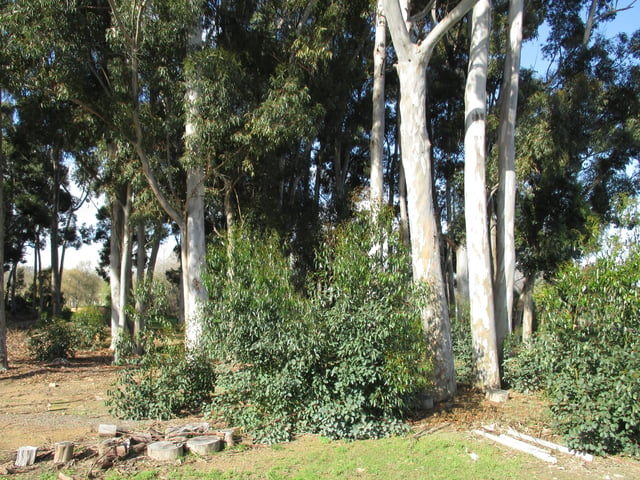
Near the ground these Eucalyptus
A structurally complete leaf of an angiosperm consists of a petiole (leaf stalk), a lamina (leaf blade), and stipules (small structures located to either side of the base of the petiole). Not every species produces leaves with all of these structural components. Stipules may be conspicuous (e.g. beans and roses, soon falling or otherwise not obvious as in Moraceae or absent altogether as in the Magnoliaceae. A petiole may be absent, or the blade may not be laminar (flattened). The tremendous variety shown in leaf structure (anatomy) from species to species is presented in detail below under. The petiole mechanically links the leaf to the plant and provides the route for transfer of water and sugars to and from the leaf. The lamina is typically the location of the majority of photosynthesis. The upper (adaxial) angle between a leaf and a stem is known as the axil of the leaf. It is often the location of a bud. Structures located there are called "axillary".
External leaf characteristics, such as shape, margin, hairs, the petiole, and the presence of stipules and glands, are frequently important for identifying plants to family, genus or species levels, and botanists have developed a rich terminology for describing leaf characteristics. Leaves almost always have determinate growth. They grow to a specific pattern and shape and then stop. Other plant parts like stems or roots have non-determinate growth, and will usually continue to grow as long as they have the resources to do so.
The type of leaf is usually characteristic of a species (monomorphic), although some species produce more than one type of leaf (dimorphic or polymorphic). The longest leaves are those of the Raffia palm, R. regalis which may be up to 25 m (82 ft) long and 3 m (9.8 ft) wide. The terminology associated with the description of leaf morphology is presented, in illustrated form, at Wikibooks.
Where leaves are basal, and lie on the ground, they are referred to as prostrate.
Basic leaf types
Ferns have fronds
Conifer leaves are typically needle- or awl-shaped or scale-like
Angiosperm (flowering plant) leaves: the standard form includes stipules, a petiole, and a lamina
Lycophytes have microphyll leaves.
Sheath leaves (type found in most grasses and many other monocots)
Other specialized leaves (such as those of Nepenthes
Arrangement on the stem
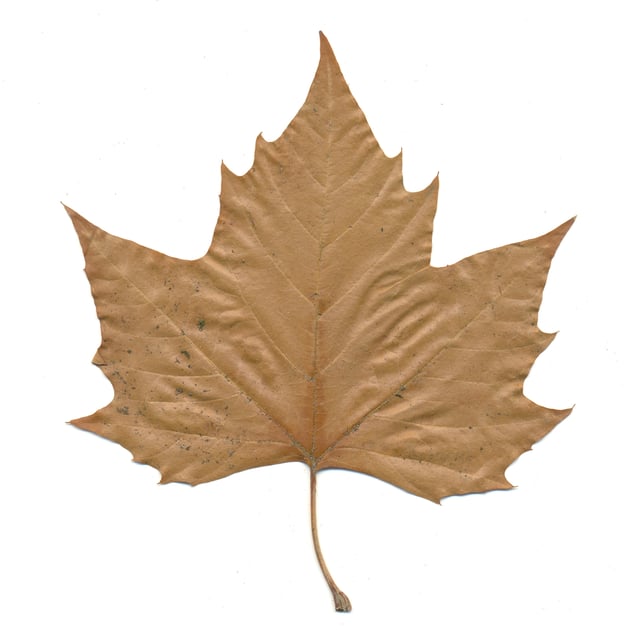
A leaf shed in autumn.
Different terms are usually used to describe the arrangement of leaves on the stem (phyllotaxis):
- AlternateOne leaf, branch, or flower part attaches at each point or node on the stem, and leaves alternate direction, to a greater or lesser degree, along the stem.BasalArising from the base of the stem.CaulineArising from the aerial stem.OppositeTwo leaves, branches, or flower parts attach at each point or node on the stem.Leaf attachments are paired at each node anddecussateif, as typical, each successive pair is rotated 90° progressing along the stem.Whorled, or verticillateThree or more leaves, branches, or flower parts attach at each point or node on the stem.As with opposite leaves, successive whorls may or may not be decussate, rotated by half the angle between the leaves in the whorl (i.e., successive whorls of three rotated 60°, whorls of four rotated 45°, etc.). Opposite leaves may appear whorled near the tip of the stem.Pseudoverticillatedescribes an arrangement only appearing whorled, but not actually so.RosulateLeaves form arosette.RowsThe term,distichous, literally meanstwo rows.Leaves in this arrangement may be alternate or opposite in their attachment.The term,2-ranked, is equivalent.The terms,tristichousandtetrastichous, are sometimes encountered.For example, the "leaves" (actuallymicrophylls) of most species ofSelaginella
As a stem grows, leaves tend to appear arranged around the stem in a way that optimizes yield of light. In essence, leaves form a helix pattern centered around the stem, either clockwise or counterclockwise, with (depending upon the species) the same angle of divergence. There is a regularity in these angles and they follow the numbers in a Fibonacci sequence : 1/2, 2/3, 3/5, 5/8, 8/13, 13/21, 21/34, 34/55, 55/89. This series tends to the golden angle, which is approximately 360° × 34/89 ≈ 137.52° ≈ 137° 30′. In the series, the numerator indicates the number of complete turns or "gyres" until a leaf arrives at the initial position and the denominator indicates the number of leaves in the arrangement. This can be demonstrated by the following:
Alternate leaves have an angle of 180° (or 1/2)
120° (or 1/3): 3 leaves in 1 circle
144° (or 2/5): 5 leaves in 2 gyres
135° (or 3/8): 8 leaves in 3 gyres.
Divisions of the blade
.jpg)
Translucent glands in Citrus
Two basic forms of leaves can be described considering the way the blade (lamina) is divided.
A simple leaf has an undivided blade. However, the leaf may be dissected to form lobes, but the gaps between lobes do not reach to the main vein. A compound leaf has a fully subdivided blade, each leaflet of the blade being separated along a main or secondary vein. The leaflets may have petiolules and stipels, the equivalents of the petioles and stipules of leaves. Because each leaflet can appear to be a simple leaf, it is important to recognize where the petiole occurs to identify a compound leaf. Compound leaves are a characteristic of some families of higher plants, such as the Fabaceae. The middle vein of a compound leaf or a frond, when it is present, is called a rachis.
- Palmately compoundLeaves have the leaflets radiating from the end of the petiole, like fingers of the palm of a hand; e.g.,Cannabis(hemp) andAesculusPinnately compoundLeaves have the leaflets arranged along the main or mid-vein.
- With a terminal leaflet; e.g.,FraxinusLacking a terminal leaflet; e.g.,Swietenia(mahogany).A specific type of even pinnate is bipinnate, where leaves only consist of two leaflets; e.g.Hymenaea
- Bipinnately compoundLeaves are twice divided: the leaflets are arranged along a secondary vein that is one of several branching off the rachis.Each leaflet is called apinnule.The group of pinnules on each secondary vein forms apinna; e.g.,AlbiziaTrifoliate (or trifoliolate)A pinnate leaf with just three leaflets; e.g.,Trifolium(clover),LaburnumPinnatifidPinnately dissected to the central vein, but with the leaflets not entirely separate; e.g.,Polypodium, someSorbus(whitebeams).In pinnately veined leaves the central vein in known as themidrib.
Characteristics of the petiole
Petiolated leaves have a petiole (leaf stalk), and are said to be petiolate.
Sessile (epetiolate) leaves have no petiole and the blade attaches directly to the stem. Subpetiolate leaves are nearly petiolate or have an extremely short petiole and may appear to be sessile.
In clasping or decurrent leaves, the blade partially surrounds the stem.
When the leaf base completely surrounds the stem, the leaves are said to be perfoliate, such as in Eupatorium perfoliatum
In peltate leaves, the petiole attaches to the blade inside the blade margin.
In some Acacia species, such as the koa tree (Acacia koa ), the petioles are expanded or broadened and function like leaf blades; these are called phyllodes. There may or may not be normal pinnate leaves at the tip of the phyllode.
A stipule, present on the leaves of many dicotyledons, is an appendage on each side at the base of the petiole, resembling a small leaf. Stipules may be lasting and not be shed (a stipulate leaf, such as in roses and beans), or be shed as the leaf expands, leaving a stipule scar on the twig (an exstipulate leaf). The situation, arrangement, and structure of the stipules is called the "stipulation".
- Free, lateralAs inHibiscusAdnateFused to the petiole base, as inRosa OchreateProvided withochrea, or sheath-formed stipules, as inPolygonaceae; e.g.,rhubarb.Encircling the petiole base
Veins
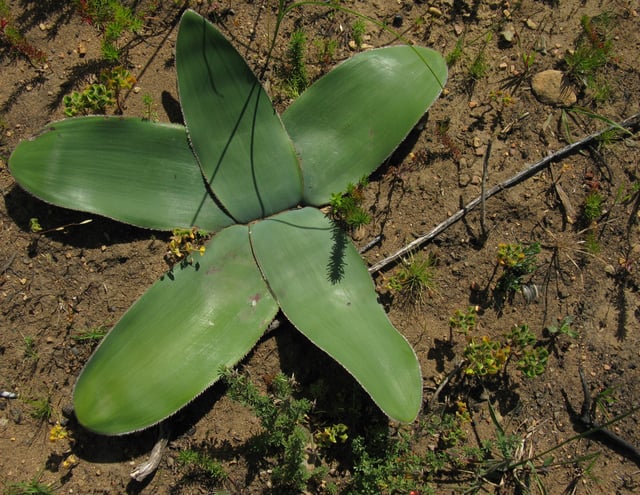
Prostrate leaves in Crossyne guttata
.jpg)
Leaves of the White Spruce (Picea glauca
Veins (sometimes referred to as nerves) constitute one of the more visible leaf traits or characteristics.
The veins in a leaf represent the vascular structure of the organ, extending into the leaf via the petiole and provide transportation of water and nutrients between leaf and stem, and play a crucial role in the maintenance of leaf water status and photosynthetic capacity.They also play a role in the mechanical support of the leaf. Within the lamina of the leaf, while some vascular plants possess only a single vein, in most this vasculature generally divides (ramifies) according to a variety of patterns (venation) and form cylindrical bundles, usually lying in the median plane of the, between the two layers of. This pattern is often specific to taxa, and of which angiosperms possess two main types, parallel and reticulate (net like). In general, parallel venation is typical of monocots, while reticulate is more typical of eudicots and magnoliids ("dicots"), though there are many exceptions.
The vein or veins entering the leaf from the petiole are called primary or first order veins.
The veins branching from these are secondary or second order veins.
These primary and secondary veins are considered major veins or lower order veins, though some authors include third order.
Each subsequent branching is sequentially numbered, and these are the higher order veins, each branching being associated with a narrower vein diameter.
In parallel veined leaves, the primary veins run parallel and equidistant to each other for most of the length of the leaf and then converge or fuse (anastomose) towards the apex.
Usually many smaller minor veins interconnect these primary veins, but may terminate with very fine vein endings in the mesophyll.
Minor veins are more typical of angiosperms, which may have as many as four higher orders.
In contrast, leaves with reticulate venation there is a single (sometimes more) primary vein in the centre of the leaf, referred to as the midrib or costa and is continuous with the vasculature of the petiole more proximally.
The midrib then branches to a number of smaller secondary veins, also known as second order veins, that extend toward the leaf margins.
These often terminate in a hydathode, a secretory organ, at the margin. In turn, smaller veins branch from the secondary veins, known as tertiary or third order (or higher order) veins, forming a dense reticulate pattern. The areas or islands of mesophyll lying between the higher order veins, are called areoles. Some of the smallest veins (veinlets) may have their endings in the areoles, a process known as areolation. These minor veins act as the sites of exchange between the mesophyll and the plant's vascular system. Thus minor veins collect the products of photosynthesis (photosynthate) from the cells where it takes place, while major veins are responsible for its transport outside of the leaf. At the same time water is being transported in the opposite direction.
The number of vein endings is very variable, as is whether second order veins end at the margin, or link back to other veins.
There are many elaborate variations on the patterns that the leaf veins form, and these have functional implications.
Of these, angiosperms have the greatest diversity.
Within these the major veins function as the support and distribution network for leaves and are correlated with leaf shape.
For instance the parallel venation found in most monocots correlates with their elongated leaf shape and wide leaf base, while reticulate venation is seen in simple entire leaves, while digitate leaves typically have venation in which three or more primary veins diverge radially from a single point.
In evolutionary terms, early emerging taxa tend to have dichotomous branching with reticulate systems emerging later. Veins appeared in the Permian period (299–252 mya), prior to the appearance of angiosperms in the Triassic (252–201 mya), during which vein hierarchy appeared enabling higher function, larger leaf size and adaption to a wider vaiety of climatic conditions. Although it is the more complex pattern, branching veins appear to be plesiomorphic and in some form were present in ancient seed plants as long as 250 million years ago. A pseudo-reticulate venation that is actually a highly modified penniparallel one is an autapomorphy of some Melanthiaceae, which are monocots; e.g., Paris quadrifolia
Morphology changes within a single plant
- HomoblastyCharacteristic in which a plant has small changes in leaf size, shape, and growth habit between juvenile and adult stages, in contrast to;
- HeteroblastyCharacteristic in which a plant has marked changes in leaf size, shape, and growth habit between juvenile and adult stages.
Anatomy (medium and small scale)
Medium-scale features
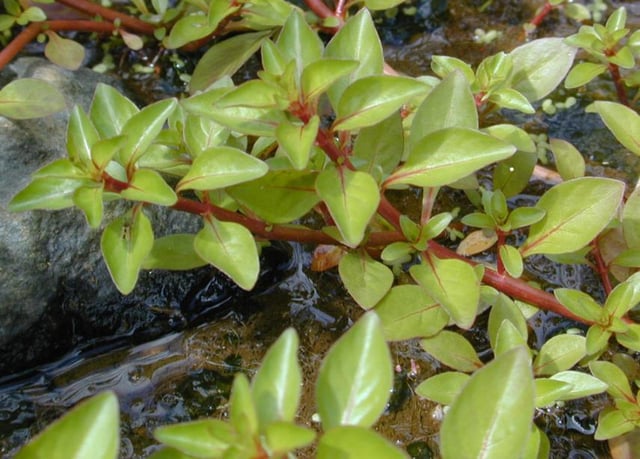
The leaves on this plant are arranged in pairs opposite one another, with successive pairs at right angles to each other (decussate) along the red stem. Note the developing buds in the axils of these leaves.
Leaves are normally extensively vascularised and typically have networks of vascular bundles containing xylem, which supplies water for photosynthesis, and phloem, which transports the sugars produced by photosynthesis. Many leaves are covered in trichomes (small hairs) which have diverse structures and functions.
Small-scale features
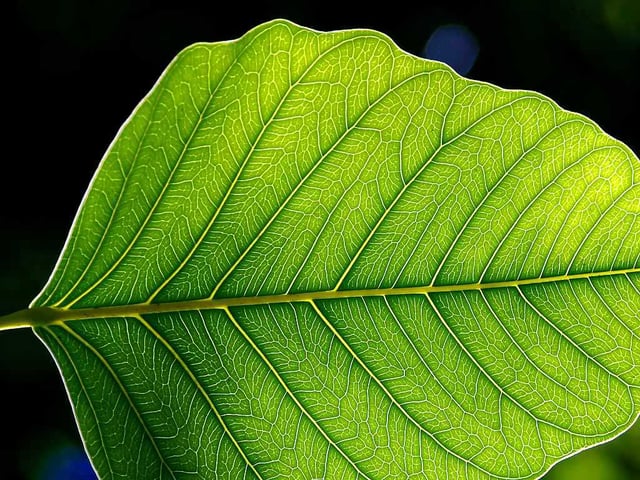
A leaf with laminar structure and pinnate venation
The major tissue systems present are
The epidermis
The mesophyll tissue inside the leaf, which is rich in chloroplasts (also called chlorenchyma)
The arrangement of veins (the vascular tissue)
These three tissue systems typically form a regular organisation at the cellular scale.
Specialised cells that differ markedly from surrounding cells, and which often synthesise specialised products such as crystals, are termed idioblasts.
Major leaf tissues
Epidermis
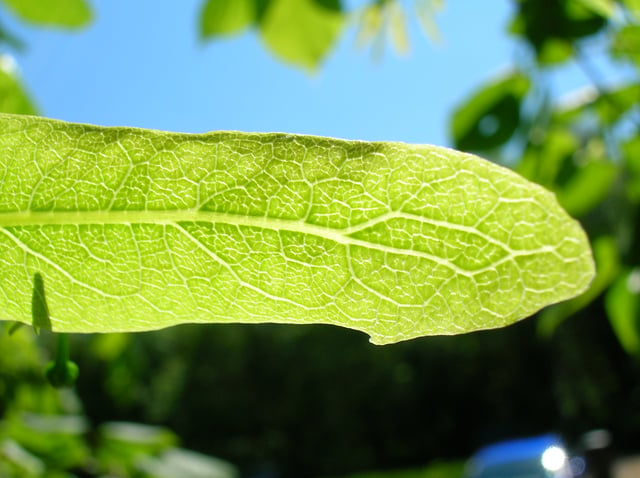
The venation within the bract of a lime tree
The epidermis is the outer layer of cells covering the leaf. It is covered with a waxy cuticle which is impermeable to liquid water and water vapor and forms the boundary separating the plant's inner cells from the external world. The cuticle is in some cases thinner on the lower epidermis than on the upper epidermis, and is generally thicker on leaves from dry climates as compared with those from wet climates. The epidermis serves several functions: protection against water loss by way of transpiration, regulation of gas exchange and secretion of metabolic compounds. Most leaves show dorsoventral anatomy: The upper (adaxial) and lower (abaxial) surfaces have somewhat different construction and may serve different functions.
The epidermis tissue includes several differentiated cell types; epidermal cells, epidermal hair cells (trichomes), cells in the stomatal complex; guard cells and subsidiary cells. The epidermal cells are the most numerous, largest, and least specialized and form the majority of the epidermis. They are typically more elongated in the leaves of monocots than in those of dicots.
Chloroplasts are generally absent in epidermal cells, the exception being the guard cells of the stomata. The stomatal pores perforate the epidermis and are surrounded on each side by chloroplast-containing guard cells, and two to four subsidiary cells that lack chloroplasts, forming a specialized cell group known as the stomatal complex. The opening and closing of the stomatal aperture is controlled by the stomatal complex and regulates the exchange of gases and water vapor between the outside air and the interior of the leaf. Stomata therefore play the important role in allowing photosynthesis without letting the leaf dry out. In a typical leaf, the stomata are more numerous over the abaxial (lower) epidermis than the adaxial (upper) epidermis and are more numerous in plants from cooler climates.
Mesophyll
Most of the interior of the leaf between the upper and lower layers of epidermis is a parenchyma (ground tissue) or chlorenchyma tissue called the mesophyll (Greek for "middle leaf"). This assimilation tissue is the primary location of photosynthesis in the plant. The products of photosynthesis are called "assimilates".
In ferns and most flowering plants, the mesophyll is divided into two layers:
An upper palisade layer of vertically elongated cells, one to two cells thick, directly beneath the adaxial epidermis, with intercellular air spaces between them. Its cells contain many more chloroplasts than the spongy layer. These long cylindrical cells are regularly arranged in one to five rows. Cylindrical cells, with the chloroplasts close to the walls of the cell, can take optimal advantage of light. The slight separation of the cells provides maximum absorption of carbon dioxide. Sun leaves have a multi-layered palisade layer, while shade leaves or older leaves closer to the soil are single-layered.
Beneath the palisade layer is the spongy layer. The cells of the spongy layer are more branched and not so tightly packed, so that there are large intercellular air spaces between them for oxygen and carbon dioxide to diffuse in and out of during respiration and photosynthesis. These cells contain fewer chloroplasts than those of the palisade layer. The pores or stomata of the epidermis open into substomatal chambers, which are connected to the intercellular air spaces between the spongy and palisade mesophyll cells.
Leaves are normally green, due to chlorophyll in chloroplasts in the mesophyll cells. Plants that lack chlorophyll cannot photosynthesize.
Vascular tissue
.jpg)
Micrograph of a leaf skeleton
The veins are the vascular tissue of the leaf and are located in the spongy layer of the mesophyll. The pattern of the veins is called. In angiosperms the venation is typically parallel in monocotyledons and forms an interconnecting network in broad-leaved plants. They were once thought to be typical examples of pattern formation through ramification, but they may instead exemplify a pattern formed in a stress tensor field.
A vein is made up of a vascular bundle. At the core of each bundle are clusters of two distinct types of conducting cells:
The xylem typically lies on the adaxial side of the vascular bundle and the phloem typically lies on the abaxial side.
Both are embedded in a dense parenchyma tissue, called the sheath, which usually includes some structural collenchyma tissue.
Leaf development
According to Agnes Arber's partial-shoot theory of the leaf, leaves are partial shoots, being derived from leaf primordia of the shoot apex. Compound leaves are closer to shoots than simple leaves. Developmental studies have shown that compound leaves, like shoots, may branch in three dimensions. On the basis of molecular genetics, Eckardt and Baum (2010) concluded that "it is now generally accepted that compound leaves express both leaf and shoot properties."
Ecology
Biomechanics
Plants respond and adapt to environmental factors, such as light and mechanical stress from wind.
Leaves need to support their own mass and align themselves in such a way as to optimise their exposure to the sun, generally more or less horizontally.
However horizontal alignment maximises exposure to bending forces and failure from stresses such as wind, snow, hail, falling debris, animals, and abrasion from surrounding foliage and plant structures.
Overall leaves are relatively flimsy with regard to other plant structures such as stems, branches and roots.
Both leaf blade and petiole structure influence the leaf's response to forces such as wind, allowing a degree of repositioning to minimise drag and damage, as opposed to resistance. Such leaf movement may also increase turbulence of the air close to the surface of the leaf, which thins the boundary layer of air immediately adjacent to the surface, increasing the capacity for gas and heat exchange, as well as photosynthesis. Strong wind forces may result in diminished leaf number and surface area, which while reducing drag, involves a trade off of also reduces photosynthesis. Thus, leaf design may involve compromise between carbon gain, thermoregulation and water loss on the one hand, and the cost of sustaining both static and dynamic loads. In vascular plants, perpendicular forces are spread over a larger area and are relatively flexible in both bending and torsion, enabling elastic deforming without damage.
Many leaves rely on hydrostatic support arranged around a skeleton of vascular tissue for their strength, which depends on maintaining leaf water status. Both the mechanics and architecture of the leaf reflect the need for transportation and support. Read and Stokes (2006) consider two basic models, the "hydrostatic" and "I-beam leaf" form (see Fig 1). Hydrostatic leaves such as in Prostanthera lasianthos are large and thin, and may involve the need for multiple leaves rather single large leaves because of the amount of veins needed to support the periphery of large leaves. But large leaf size favours efficiency in photosynthesis and water conservation, involving further trade offs. On the other hand, I-beam leaves such as Banksia marginata involve specialised structures to stiffen them. These I-beams are formed from bundle sheath extensions of sclerenchyma meeting stiffened sub-epidermal layers. This shifts the balance from reliance on hydrostatic pressure to structural support, an obvious advantage where water is relatively scarce. Long narrow leaves bend more easily than ovate leaf blades of the same area. Monocots typically have such linear leaves that maximise surface area while minimising self-shading. In these a high proportion of longitudinal main veins provide additional support.
Interactions with other organisms
Although not as nutritious as other organs such as fruit, leaves provide a food source for many organisms.
The leaf is a vital source of energy production for the plant, and plants have evolved protection against animals that consume leaves, such as tannins, chemicals which hinder the digestion of proteins and have an unpleasant taste. Animals that are specialized to eat leaves are known as folivores.
Some species have cryptic adaptations by which they use leaves in avoiding predators. For example, the caterpillars of some leaf-roller moths will create a small home in the leaf by folding it over themselves. Some sawflies similarly roll the leaves of their food plants into tubes. Females of the Attelabidae, so-called leaf-rolling weevils, lay their eggs into leaves that they then roll up as means of protection. Other herbivores and their predators mimic the appearance of the leaf. Reptiles such as some chameleons, and insects such as some katydids, also mimic the oscillating movements of leaves in the wind, moving from side to side or back and forth while evading a possible threat.
Seasonal leaf loss
Leaves in temperate, boreal, and seasonally dry zones may be seasonally deciduous (falling off or dying for the inclement season). This mechanism to shed leaves is called abscission. When the leaf is shed, it leaves a leaf scar on the twig. In cold autumns, they sometimes change color, and turn yellow, bright-orange, or red, as various accessory pigments (carotenoids and xanthophylls) are revealed when the tree responds to cold and reduced sunlight by curtailing chlorophyll production. Red anthocyanin pigments are now thought to be produced in the leaf as it dies, possibly to mask the yellow hue left when the chlorophyll is lost—yellow leaves appear to attract herbivores such as aphids. Optical masking of chlorophyll by anthocyanins reduces risk of photo-oxidative damage to leaf cells as they senesce, which otherwise may lower the efficiency of nutrient retrieval from senescing autumn leaves.
Evolutionary adaptation
In the course of evolution, leaves have adapted to different environments in the following ways:
Waxy micro- and nanostructures on the surface reduce wetting by rain and adhesion of contamination (Lotus effect
Divided and compound leaves reduce wind resistance and promote cooling.
Hairs on the leaf surface trap humidity in dry climates and create a boundary layer reducing water loss.
Waxy plant cuticles reduce water loss.
Large surface area provides a large area for capture of sunlight.
In harmful levels of sunlight, specialised leaves, opaque or partly buried, admit light through a translucent leaf window for photosynthesis at inner leaf surfaces (e.g. Fenestraria
Succulent leaves store water and organic acids for use in CAM photosynthesis.
Aromatic oils, poisons or pheromones produced by leaf borne glands deter herbivores (e.g. eucalypts).
Inclusions of crystalline minerals deter herbivores (e.g. silica phytoliths in grasses, raphides in Araceae).
Petals attract pollinators.
Spines protect the plants from herbivores (e.g. cacti).
Stinging hairs to protect against herbivory, e.g. in Urtica dioica and Dendrocnide moroides (Urticaceae).
Special leaves on carnivorous plants are adapted for trapping food, mainly invertebrate prey, though some species trap small vertebrates as well (see carnivorous plants).
Bulbs store food and water (e.g. onions).
Tendrils allow the plant to climb (e.g. peas).
Bracts and pseudanthia (false flowers) replace normal flower structures when the true flowers are greatly reduced (e.g. spurges and spathes in the Araceae.
Terminology
Shape
Edge (margin)
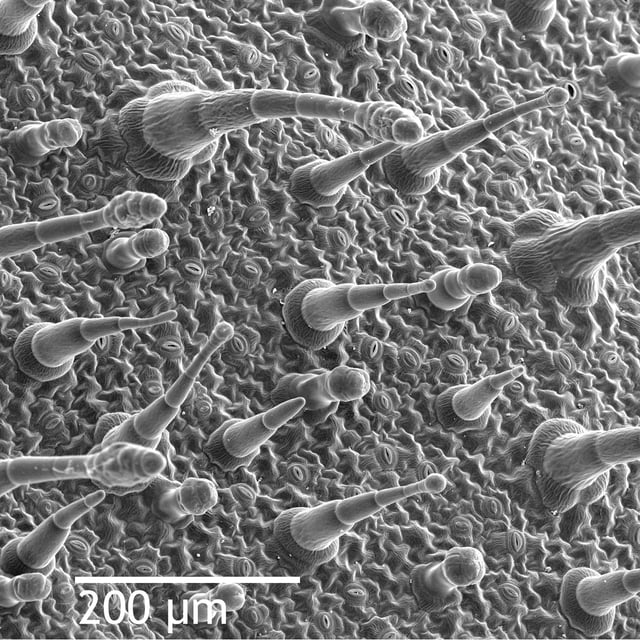
SEM image of the leaf epidermis of Nicotiana alata , showing trichomes (hair-like appendages) and stomata (eye-shaped slits, visible at full resolution).
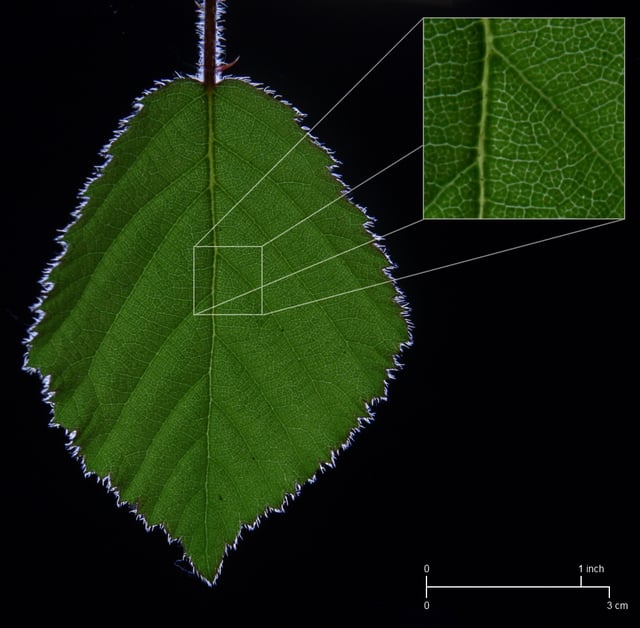
The veins of a bramble leaf
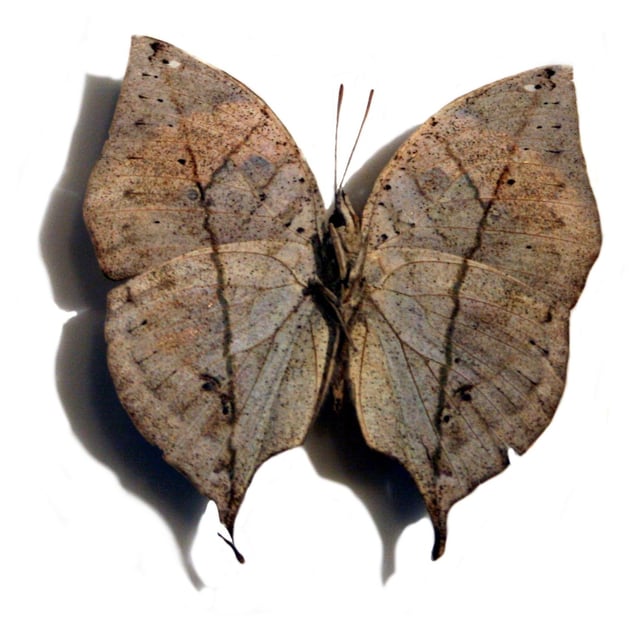
Some insects, like Kallima inachus
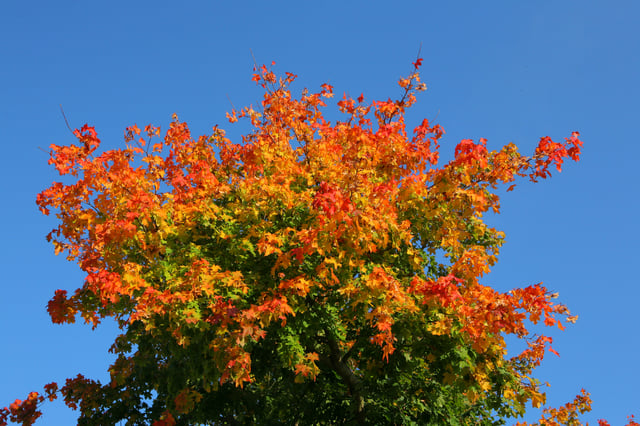
Leaves shifting color in autumn (fall)
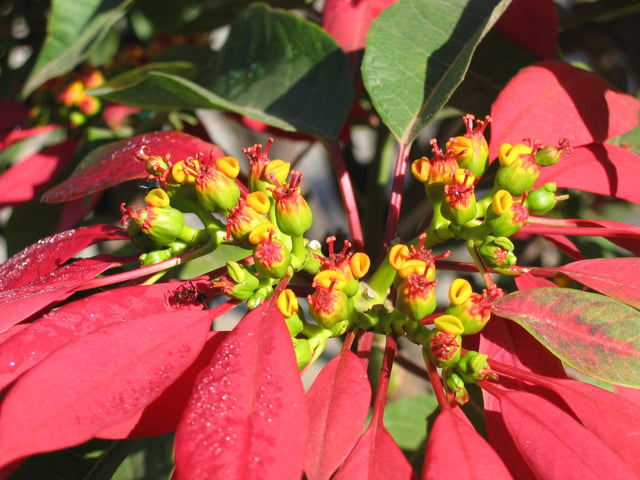
Poinsettia bracts are leaves which have evolved red pigmentation in order to attract insects and birds to the central flowers, an adaptive function normally served by petals (which are themselves leaves highly modified by evolution).

Leaf morphology terms

Leaves showing various morphologies.
| Image | Term | Latin | Description |
|---|---|---|---|
| Entire | Formaintegra | Even; with a smooth margin; without toothing | |
May be coarsely dentate, having large teeth
or glandular dentate, having teeth which bear glands
Apex (tip)
| Image | Term | Latin | Description |
|---|---|---|---|
| Acuminate | _ | Long-pointed, prolonged into a narrow, tapering point in a concave manner | |
| Acute | _ | Ending in a sharp, but not prolonged point | |
| Cuspidate | _ | With a sharp, elongated, rigid tip; tipped with a cusp | |
| Emarginate | _ | Indented, with a shallow notch at the tip | |
| Mucronate | _ | Abruptly tipped with a small short point | |
| Mucronulate | _ | Mucronate, but with a noticeably diminutive spine | |
| Obcordate | _ | Inversely heart-shaped | |
| Obtuse | _ | Rounded or blunt | |
| Truncate | _ | Ending abruptly with a flat end |
Base
- AcuminateComing to a sharp, narrow, prolonged point.AcuteComing to a sharp, but not prolonged point.AuriculateEar-shaped.CordateHeart-shaped with the notch towards the stalk.CuneateWedge-shaped.HastateShaped like an halberd and with the basal lobes pointing outward.ObliqueSlanting.ReniformKidney-shaped but rounder and broader than long.RoundedCurving shape.SagittateShaped like an arrowhead and with the acute basal lobes pointing downward.TruncateEnding abruptly with a flat end, that looks cut off.
Surface
- CoriaceousLeathery; stiff and tough, but somewhat flexible.FarinoseBearing farina; mealy, covered with a waxy, whitish powder.GlabrousSmooth, not hairy.GlaucousWith a whitish bloom; covered with a very fine, bluish-white powder.GlutinousSticky, viscid.LepidoteCoated with small scales (thuselepidote, without such scales).MaculateStained, spotted, compareimmaculate.Papillate, or papilloseBearing papillae (minute, nipple-shaped protuberances).PubescentCovered with erect hairs (especially soft and short ones).PunctateMarked with dots; dotted with depressions or with translucent glands or colored dots.RugoseDeeply wrinkled; with veins clearly visible.ScurfyCovered with tiny, broad scalelike particles.TuberculateCovered with tubercles; covered with warty prominences.VerrucoseWarted, with warty outgrowths.Viscid, or viscousCovered with thick, sticky secretions.
The leaf surface is also host to a large variety of microorganisms; in this context it is referred to as the phyllosphere.
Hairiness
"Hairs" on plants are properly called trichomes. Leaves can show several degrees of hairiness. The meaning of several of the following terms can overlap.
- Arachnoid, or arachnoseWith many fine, entangled hairs giving a cobwebby appearance.BarbellateWith finely barbed hairs (barbellae).BeardedWith long, stiff hairs.BristlyWith stiff hair-like prickles.CanescentHoary with dense grayish-white pubescence.CiliateMarginally fringed with short hairs (cilia).CiliolateMinutely ciliate.FloccoseWith flocks of soft, woolly hairs, which tend to rub off.GlabrescentLosing hairs with age.GlabrousNo hairs of any kind present.GlandularWith a gland at the tip of the hair.HirsuteWith rather rough or stiff hairs.HispidWith rigid, bristly hairs.HispidulousMinutely hispid.HoaryWith a fine, close grayish-white pubescence.Lanate, or lanoseWith woolly hairs.PiloseWith soft, clearly separated hairs.Puberulent, or puberulousWith fine, minute hairs.PubescentWith soft, short and erect hairs.Scabrous, or scabridRough to the touch.SericeousSilky appearance through fine, straight and appressed (lying close and flat) hairs.SilkyWith adpressed, soft and straight pubescence.Stellate, or stelliformWith star-shaped hairs.StrigoseWith appressed, sharp, straight and stiff hairs.TomentoseDensely pubescent with matted, soft white woolly hairs.TomentuloseMinutely or only slightly tomentose.VillousWith long and soft hairs, usually curved.WoollyWith long, soft and tortuous or matted hairs.
Timing
- HysteranthousDeveloping after the flowersSynanthousDeveloping at the same time as the flowers
Venation
Classification
A number of different classification systems of the patterns of leaf veins (venation or veination) have been described, starting with Ettingshausen (1861), together with many different descriptive terms, and the terminology has been described as "formidable".
One of the commonest among these is the Hickey system, originally developed for "dicotyledons" and using a number of Ettingshausen's terms derived from Greek (1973–1979): (see also : Simpson Figure 9.12, p. 468)
Hickey system
- Parallelodromous (parallel-veined, parallel-ribbed, parallel-nerved, penniparallel, striate)
- Campylodromous (
- curve)
- Acrodromous
- Actinodromous
- Palinactodromous
Types 4–6 may similarly be subclassified as basal (primaries joined at the base of the blade) or suprabasal (diverging above the blade base), and perfect or imperfect, but also flabellate.
At about the same time, Melville (1976) described a system applicable to all Angiosperms and using Latin and English terminology.
Melville also had six divisions, based on the order in which veins develop.
- Arbuscular (arbuscularis)Branching repeatedly by regular dichotomy to give rise to a three dimensional bush-like structure consisting of linear segment (2 subclasses)Flabellate (flabellatus)Primary veins straight or only slightly curved, diverging from the base in a fan-like manner (4 subclasses)Palmate (palmatus)Curved primary veins (3 subclasses)Pinnate (pinnatus)Single primary vein, the midrib, along which straight or arching secondary veins are arranged at more or less regular intervals (6 subclasses)Collimate (collimatus)Numerous longitudinally parallel primary veins arising from a transverse meristem (5 subclasses)Conglutinate (conglutinatus)Derived from fused pinnate leaflets (3 subclasses)
A modified form of the Hickey system was later incorporated into the Smithsonian classification (1999) which proposed seven main types of venation, based on the architecture of the primary veins, adding Flabellate as an additional main type.
Further classification was then made on the basis of secondary veins, with 12 further types, such as;
- BrochidodromousClosed form in which the secondaries are joined together in a series of prominent arches, as inHildegardiaCraspedodromousOpen form with secondaries terminating at the margin, in toothed leaves, as inCeltisEucamptodromousIntermediate form with upturned secondaries that gradually diminish apically but inside the margin, and connected by intermediate tertiary veins rather than loops between secondaries, as inCornusCladodromousSecondaries freely branching toward the margin, as inRhus
terms which had been used as subtypes in the original Hickey system.
Further descriptions included the higher order, or minor veins and the patterns of areoles (see Leaf Architecture Working Group, Figures 28–29).
Adiantum cunninghamii]] ]]
- FlabellateSeveral to many equal fine basal veins diverging radially at low angles and branching apically.E.g.Paranomus
Analyses of vein patterns often fall into consideration of the vein orders, primary vein type, secondary vein type (major veins), and minor vein density.
A number of authors have adopted simplified versions of these schemes.
At its simplest the primary vein types can be considered in three or four groups depending on the plant divisions being considered;
pinnate
palmate
parallel
where palmate refers to multiple primary veins that radiate from the petiole, as opposed to branching from the central main vein in the pinnate form, and encompasses both of Hickey types 4 and 5, which are preserved as subtypes; e.g., palmate-acrodromous (see National Park Service Leaf Guide).
Acer truncatum]] ]]
- Palmate, Palmate-netted, palmate-veined, fan-veinedSeveral main veins of approximately equal sizedivergefrom a common point near the leaf base where the petiole attaches, and radiate toward the edge of the leaf.Palmately veined leaves are often lobed or divided with lobes radiating from the common point.They may vary in the number of primary veins (3 or more), but always radiate from a common point.e.g. mostAcer(maples).
Other systems
Alternatively, Simpson uses:
- UninervousCentral midrib with no lateral veins (microphyllous), seen in the non-seed bearingtracheophytes, such ashorsetailsDichotomousVeins successively branching into equally sized veins from a common point, forming a Y junction, fanning out.Amongst temperate woody plants,Ginkgo bilobais the only species exhibiting dichotomous venation.Also somepteridophytes(ferns).ParallelPrimary and secondary veins roughly parallel to each other, running the length of the leaf, often connected by short perpendicular links, rather than form networks.In some species, the parallel veins join together at the base and apex, such as needle-type evergreens and grasses.Characteristic of monocotyledons, but exceptions includeArisaemaNetted (reticulate, pinnate)A prominent midvein with secondary veins branching off along both sides of it.The name derives from the ultimate veinlets which form an interconnecting net like pattern or network.(The primary and secondary venation may be referred to as pinnate, while the net like finer veins are referred to as netted or reticulate); most non-monocot angiosperms, exceptions includingCalophyllum.Some monocots have reticulate venation, includingColocasia,DioscoreaandSmilax
However, these simplified systems allow for further division into multiple subtypes.
Simpson, (and others) divides parallel and netted (and some use only these two terms for Angiosperms) on the basis of the number of primary veins (costa) as follows;
- ParallelNetted (Reticulate)
These complex systems are not used much in morphological descriptions of taxa, but have usefulness in plant identification, although criticized as being unduly burdened with jargon.
An older, even simpler system, used in some flora uses only two categories, open and closed.
Open: Higher order veins have free endings among the cells and are more characteristic of non-monocotyledon angiosperms.
They are more likely to be associated with leaf shapes that are toothed, lobed or compound.
They may be subdivided as; Pinnate (feather-veined) leaves, with a main central vein or rib (midrib), from which the remainder of the vein system arises Palmate, in which three or more main ribs rise together at the base of the leaf, and diverge upward.
Dichotomous, as in ferns, where the veins fork repeatedly
Closed: Higher order veins are connected in loops without ending freely among the cells.
These tend to be in leaves with smooth outlines, and are characteristic of monocotyledons.
They may be subdivided into whether the veins run parallel, as in grasses, or have other patterns.
Other descriptive terms
There are also many other descriptive terms, often with very specialised usage and confined to specific taxonomic groups.
The conspicuousness of veins depends on a number of features.
These include the width of the veins, their prominence in relation to the lamina surface and the degree of opacity of the surface, which may hide finer veins.
In this regard, veins are called obscure and the order of veins that are obscured and whether upper, lower or both surfaces, further specified.
Terms that describe vein prominence include bullate, channelled, flat, guttered, impressed, prominent and recessed (Fig. 6.1 Hawthorne & Lawrence 2013). Veins may show different types of prominence in different areas of the leaf. For instance Pimenta racemosa has a channelled midrib on the upper surfae, but this is prominent on the lower surface.
Describing vein prominence:
- BullateSurface of leaf raised in a series of domes between the veins on the upper surface, and therefore also with marked depressions.e.g.Rytigynia pauciflora,Vitis viniferaChannelled (canalicululate)Veins sunken below the surface, resulting in a rounded channel.Sometimes confused with "guttered" because the channels may function as gutters for rain to run off and allow drying, as in manyMelastomataceae.e.g. (see)Pimenta racemosaClidemia hirtaGutteredVeins partly prominent, the crest above the leaf lamina surface, but with channels running along each side, like guttersImpressedVein forming raised line or ridge which lies below the plane of the surface which bears it, as if pressed into it, and are often exposed on the lower surface.Tissue near the veins often appears to pucker, giving them a sunken or embossed appearanceObscureVeins not visible, or not at all clear; if unspecified, then not visible with the naked eye.e.g.Berberis gagnepainii.In thisBerberis, the veins are only obscure on the undersurface.ProminentVein raised above surrounding surface so to be easily felt when stroked with finger.e.g. (see)Pimenta racemosaSpathiphyllum cannifoliumRecessedVein is sunk below the surface, more prominent than surrounding tissues but more sunken in channel than with impressed veins.e.g.Viburnum plicatum
Describing other features:
- Plinervy(plinerved)More than one main vein (nerve) at the base.Lateral secondary veins branching from a point above the base of the leaf.Usually expressed as asuffix, as in 3-plinerved or triplinerved leaf.In a 3-plinerved (triplinerved) leaf three main veins branch above the base of the lamina (two secondary veins and the main vein) and run essentially parallel subsequently, as inCeanothusand inCeltis.Similarly a quintuplinerve (five-veined) leaf has four secondary veins and a main vein.A pattern with 3-7 veins is especially conspicuous inMelastomataceae.The term has also been used inVaccinieae.The term has been used as synonymous with acrodromous, palmate-acrodromous or suprabasal acrodromous, and is thought to be too broadly defined.ScalariformVeins arranged like the rungs of a ladder, particularly higher order veinsSubmarginalVeins running close to leaf marginTrinerved2 major basal nerves besides the midrib
| Image | Term | Description |
|---|---|---|
| Arcuate | Secondary arching toward the apex | |
| Dichotomous | Veins splitting in two | |
| Longitudinal | All veins aligned mostly with the midvein | |
| Parallel | All veins parallel and not intersecting | |
| Pinnate | Secondary veins borne from midrib | |
| Reticulate | All veins branching repeatedly, net veined | |
| Rotate | Veins coming from the center of the leaf and radiating toward the edges | |
| Transverse | Tertiary veins running perpendicular to axis of main vein, connecting secondary veins |
Size
The terms megaphyll, macrophyll, mesophyll, notophyll, microphyll, nanophyll and leptophyll are used to describe leaf sizes (in descending order), in a classification devised in 1934 by Christen C. Raunkiær and since modified by others.
See also
Glossary of leaf morphology
Glossary of plant morphology:Leaves
Crown (botany)
Evolutionary history of leaves
Evolutionary development of leaves
Leaf Area Index
Leaf protein concentrate
Leaf sensor – a device that measures the moisture level in plant leaves
Leaf shape
Vernation – sprouting of leaves, also the arrangement of leaves in the bud
